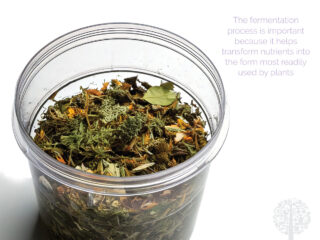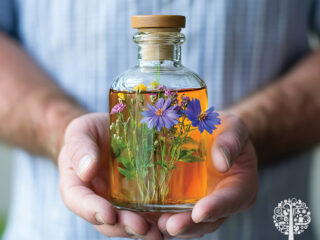Getting Witchy with It: Making Botanical Brews for Garden Fertility
We are all feeling it. The cost of everything keeps going up, and it seems like there is no end in sight. From seeds and fertilisers to labour, increased input costs are cutting into already minuscule profit margins. But, as gardeners and farmers, is there something we are missing? We are often told “there are no free lunches”, which, in essence, is mostly true. Still, the foundational basis of agriculture relies largely upon free energy from the sun converted to free chemical energy by plants (ideally with an evolutionary relationship with soil microbes). Is there more that we can gain from what Nature is already providing us?
If we could visualise Nature in a time-lapse, we would see that plants are fertilising plants. Not in the traditional sense of spreading alfalfa or soybean meal or incorporating green manure or mulch, but rather in a microbial decomposition of plant material — not overly fancy, just a gradual decay. Recognising this nutrient fertility cycle, enhancing plant breakdown through composting or fermentation makes sense. However, as a species, sapiens seem to make even the simplest things so complicated that we feel we need to be “experts” to do something natural.
A renaissance of regenerative agricultural practices, which have been the foundational methods of natural farming for centuries in Asia, piques the interest of a new generation of growers. Practices centred around creating farm fertility based on the fermentation of plant material are among the simplest and most effective solutions that can be readily implemented, irrespective of your gardening experience.
Fermented Fertility
One of my earliest memories of gardening is coupled with feelings of embarrassment. As a first-generation Canadian, fitting in was the goal and drawing attention to yourself was to be avoided at all costs. That was not my father’s philosophy regarding the family garden; he was excited about growing the best vegetables for his family. So, creating a foul-smelling concoction to drench the backyard garden in suburbia never received a second thought. Using a plastic garbage can, we would throw in our kitchen scraps, mix in a cup of ground lentils or split peas and some jaggery (evaporated sugar cane juice) and fill it with water. A week or so later, out came the re-purposed Crisco (name-brand vegetable shortening) can, and every plant got a pungent dose. Let’s just say none of my friends were coming over for a game of tag, Red Rover, or hide-and-seek for a few days. The upshot was that we had the best garden in the neighbourhood.


Fast forward 50 years, and foul-smelling fermented plant elixirs are my primary inputs for soil health and plant nutrition for my garden. My interest in this fermented tea practice is based on its effectiveness, simplicity, and low cost (both in time and money). Still, a little of my passion comes from a need to decolonise my mind and challenge my perceptions of good and bad. In our “sanitised” world, we have been programmed to assume anything that has a “not-so-pleasant” odour may be “not-so-pleasant” for our plants. Using fermented teas will rid you of those false notions and give you a whole new perspective on microbial diversity and the robustness and redundancy of that diversity in providing plants with nutrition.
Steep, Stir, and Smell
For the same reasons we drink teas for our health, making a plant tea is primarily about steeping, allowing for the release of beneficial chemicals like antioxidants (like flavonoids), vitamins, amino acids, and elemental nutrients. The fermentation process is important because it helps transform nutrients into the form most readily used by plants. Microbes that thrive under lower oxygen environments like fermentation will help reduce (adding hydrogen) oxidised elements, putting them in a state where plant roots will allow them to enter.
Making fermented tea is as simple as cutting biomass (leaves, roots) into smaller pieces to increase surface area, throwing it into a plastic tub, covering it with rainwater, placing an air-tight lid and waiting. Some practitioners will add leaf mould as a kickstart, while others will add rock powders or bone meal, which may help with the odour. Some may add molasses, but I prefer using products like humic acid, protein hydrolysates, kelp extract, and molasses in my compost extracts.


These botanical brews serve as both a soil conditioner and plant nutrition. In the first few days of fermentation, you will notice a more gelatinous texture in the water and some active bubbling as you stir the plant material. If you use the tea within the first 3 to 7 days, you will add a probiotic to the soil. At this stage, the tea is chock full of microbes like Lactobacillus spp. Bacillus spp. Actinomyces spp., and Saccharomyces spp. (yeasts). These microbes are largely responsible for making nutrients more readily available, and many of them make primary metabolites that are precursors to the many molecules we seek in our food or medicine.
Once the tea goes beyond 14 days, the fermenting microbes have decomposed much of the plant material and created a brew filled with amino acids, vitamins, organic acids, and soluble nutrients. Some practitioners will wait 20 to 30 days before use and will typically do a dilution rate of 1:10 (soil) to 1:30 (foliar).
Seasonal Fermentation
Bringing attention to the simplicity of this practice, understand that making these botanical brews can follow the natural plant succession of your climate. In my region, signs of spring include the arrival of the dandelion (Taraxacum officinale), which is arguably one of the most readily available dynamic accumulators of both macronutrients (Ca, Mg, K) and trace elements (Fe, Zn, Cu, and Mn). However, many practitioners will design gardens or guilds to cultivate specific plants to make teas. One of the best and earliest plants for making nutrient teas is stinging nettle (Urtica dioica), which has significantly more of the same nutrients as the dandelion, along with more amino acids, Vitamin K, B vitamins and flavonoids. A fermented tea with dandelion greens (and roots) and stinging nettle is an excellent kickstart for vegetative growth. Willow (Salix spp.) shoots add a great source of the growth hormone IAA (indole acetic acid).


For most gardeners farming with biodiversity in mind, the eligible ingredients are ceaseless. Next in my garden pantry would be comfrey (Symphytum officinale), which will become the base of all of my future teas for the season because of its ability to grow so much biomass over the summer. Balanced and rich in NPK, Ca, and some Si, a comfrey fermented tea can almost be a one-and-done fertiliser. A comfrey tea, in combination with a stinging nettle, works exceptionally well on crops prone to Mg or Ca disorders like blossom end rot, cavity spot, bitter pit, or tip-burn.
The comfrey fermentation makes Si bioavailable for plant uptake, but nothing compares to a fermented horsetail tea (Equisetum arvense). Horsetail is often the next ingredient to appear on the farm and has a relatively brief window for harvest, so it is best to collect as much as you may require for the season. Preparing horsetail tea involves bringing the tea to a boil and simmering for an hour before a 1 to 2-week fermentation. The end product has up to six months of shelf life and can be added to your future teas. Si is consumed by the plant as mono-silicic acid and is readily taken up by the roots of monocots and, more readily, by the leaves of dicots. A helpful tip when using fermented horsetail tea is to do a foliar application with some fulvic acid. Horsetail tea functions as a fungal deterrent for biodynamic farmers (BD508), as the Si acts as a physical barrier for pests and pathogens and triggers an immune response within the plant, much like a vaccination (i.e., Systemic Acquired Resistance).


Understanding plant nutrient uptake allows designer fermented teas to help cater your fertility to a crop’s need. For example, teas with yarrow (Achillea millefolium) are high in K and are great for crops in bloom. German chamomile (Matricaria chamomilla) is high in S and contains high sterol levels that help plants form secondary metabolites. The common weed purslane (Portulaca oleracea) contains omega-3 fatty acids and makes for a nice tea in early flower. At the same time, alfalfa (Medicago sativa) is high in N, K, Mg, and Ca but also has a plant growth regulator called triacontanol, which aids in plant productivity. More plant biodiversity simply translates to more opportunities to address nutrient imbalances.
The world of natural farming (e.g., Korean Natural Farming (KNF) or JADAM) can often be daunting when one hears of BD (biodynamic) preps, IMO (Indigenous Micro Organisms), or FPJ (Fermented Plant Juices). However, this simple water extraction methodology of making fermented tea can be your gateway; it is simple, cost-effective, and works.




